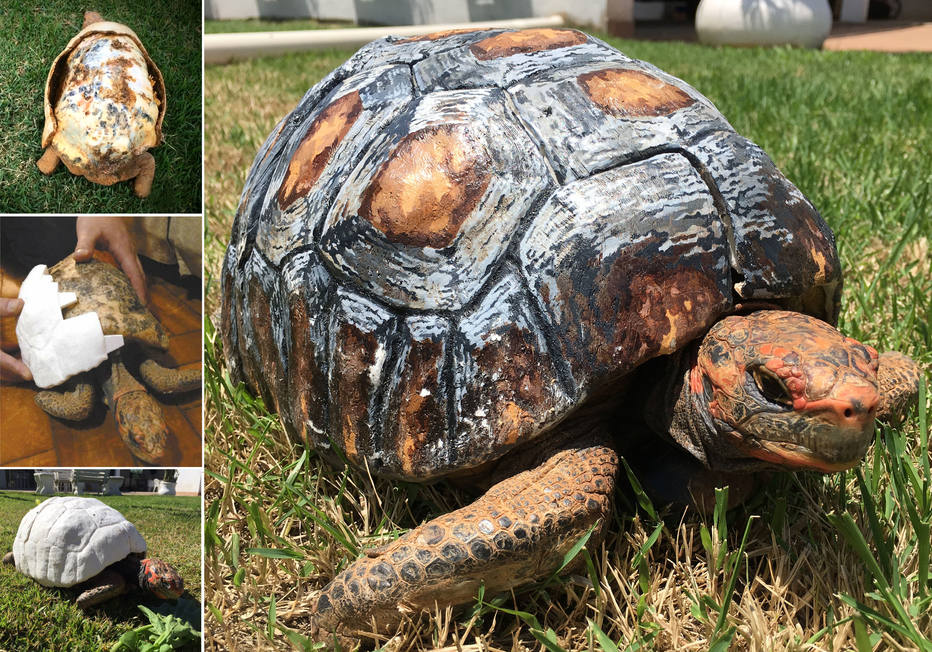A Brazilian team of volunteer professionals made up of veterinarians, dentists and a designer responsible for 3D hull reconstruction and deployment – Using the so-called 3D system – in a Jabota (female from Tortoise) Joined Guinness World Records 2022. The book was released in September.
Designer Cicero Moraes, one of the group members, resides in Sinop – Not north Matthew Grosso, 479 km from Cuiaba – , he told conditionOver the phone, which was a rebuilding project with many technical challenges to overcome before a happy ending. To reconstruct the structure, the technique known as photogrammetry was used, and it has also been used extensively by archaeologists and adapted to reconstruct skulls, crime scenes and even for architectural constructions.
baptized k Freddy, the turtle, whose body was destroyed in a shooting in the area closed, Brasília region, lost 85% of it in cremation and later lost the remaining 15%. Freddy is found by a couple on the side of the road, and taken to two veterinarian brothers, Rodrigo and Mateus Rabelo, who work with wild animals. When he arrived, the larvae of flies were devouring his body. In the process of recovery she had two bouts of pneumonia and was still 45 days without eating.
For the construction of the prosthetic, Moraes received several images to make a so-called tortoiseshell volume measurement. Then he turned to a friend who had a healthy pet tortoise: he used it as a standard. The entire skeleton of the animal was depicted in detail (upper and lower) and the entire volume was reconstructed from these images.
“we can’t go wrong”
According to Moraes, the most difficult and complicated moment in this whole process was measuring the prosthesis, in four parts, and then 3D-printing it. “In the measurement, we did not do this and could not make mistakes,” the designer recalls. Regarding printing, “not necessarily for the shape of the form only, but for the time spent on each of the prints.”
The larger pieces took 50 hours to print each. The smaller ones are a little less, between 28 and 35 hours. The impressions were made by dentists Paulo Miyamoto and Paulo Estevez, who cleaned and prepared the pieces for the surgery to be performed at a later time. It was not necessary to dress, as the group came to believe that it would be necessary. Vet Roberto Vecchio coordinated the surgical team.
behind
Moraes, in the conversation, explained that tangible evidence that “everything worked” was when the turtle returned from anesthesia. The first step was to hide in the hull of the ship. In the end, to end the whole adventure with a golden key, he mentioned the technical phase of the whole process: “We got help from the engineer Yuri Caldera, who is also an artist who lives in Brasilia.” Knowing the mission of his friends, he suggested drawing Freddy’s hull. Taken from a tortoise, brought home – Caldera devoted himself, in detail, to creating a realistic painting based on acrylic paint, which has the advantage of faster drying.
The project, from the digitization stage to putting the turtle on the body, was implemented within a month. The team of experts made up of volunteers is known as the “Animal Avengers”. This group includes Roberto Vecchio, Rodrygo, Matthews Rabelo and dentist Paulo Miyamoto.
The mission succeeded, Freddy now lives on a farm set up to receive wild animals in Brasilia. Currently, designer Cícero Moraes is already dedicated to a new mission. He takes part in reconstructing the face of a dog burned in the bush.

“Hardcore beer fanatic. Falls down a lot. Professional coffee fan. Music ninja.”


![[VÍDEO] Elton John’s final show in the UK has the crowd moving](https://www.tupi.fm/wp-content/uploads/2023/06/Elton-John-1-690x600.jpg)



More Stories
The Director of Ibict receives the Coordinator of CESU-PI – Brazilian Institute for Information in Science and Technology
A doctor who spreads fake news about breast cancer is registered with the CRM of Minas
The program offers scholarships to women in the field of science and technology